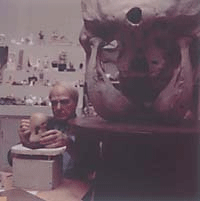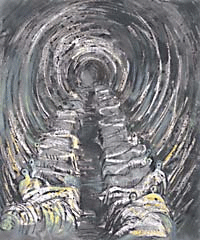Sculptor who molded open-air art
2004年
HENRY MOORE
Sculptor who molded open-air art
By KATE THOMSON
Special to The Japan Times
I have been a professional sculptor for 20 years, and in that time Henry Moore has toppled from the pedestal I put him on when I was 14 and first saw his "Helmet Head" series of bronze sculptures on display in my home city of Edinburgh.

marks its 35th anniversary by launching an exhibition devoted to the artist.
PHOTOS BY TOSHIHIDE KAJIHARA/HENRY MOORE FOUNDATION ARCHIVE/MICHEL MULLER; ALL (C)HENRY MOORE FOUNDATION
What excited me then was how vividly sculpture could convey the complexity of the human condition, navigate the currents of international art movements and also capture a sense of belonging to a particular place. Moore's work seemed to exemplify all of that.
Then, after I had spent 15 years living and working in Japan, overexposure to Moore's bronze figures dotted in the open air all over this country began to get to me. Added to that, I became disillusioned with Moore's later works that, having been scaled up by assistants from his tiny models, often lost in the translation the integrity that had so entranced me.
But a visit to "Henry Moore: The Expanse of Nature -- The Nature of Man," which opened March 19 at Hakone Open-Air Museum, was like a return to my sculptural roots and reawakened that early enthusiasm.
The first major retrospective in Japan of work by a grand master of 20th-century sculpture since the 1978 touring exhibition "In Praise of Life," this show has as its highlight the first-ever re-creation of Moore's maquette studio.
The studio captures the vitality of Moore's working process and the infinite possibilites of scale in his intense working models. Flints, pebbles, bones, shells and driftwood he gleaned from the Hertfordshire landscape north of London jostle for space with plaster maquettes, covering every avalaible surface and spilling over into old boxes, pans and tins -- a mere sample of what the artist called his "library of form."
The exhibition continues with a wealth of drawings, maquettes, carvings and models lent by Britain's Henry Moore Foundation, all carefully selected to relate to the evolution of the 26 bronzes in Hakone's significant collection and all representing the dialogue between man and nature. This is a valuable chance to rediscover the immediacy of Moore's response to materials. The visitor will come away with intriguing insights into his synthesis of found or observed forms and shapes influenced by major experiments in early 20th-century European art.

British sculptor Henry Moore reshaped the notion of public sculpture in Europe and Japan. This month Hakone Open-Air Museum, home to 26 of his bornze works.
From the start of his career in the 1920s, Moore roughed out ideas for sculpture in drawings exploring the mass and weight of the human figure. The impact of seeing Paul Cezanne's paintings in Paris in 1922 is evident in Moore's 1923-24 series of "Standing Figure" drawings.
Then in the late 1930s, many avante-garde European artists fleeing the rise of fascism congregated in dingy Hammersmith, central London, where Moore lived. In this unlikely bohemian setting Moore was part of a group that hotly debated the relative merits of Surrealism and Constructivism. Trying to resolve his fascination with both schools, Moore -- who started his career as a wood and stone carver, represented here by carvings such as his 1934 "Head and Ball" piece in Cumberland alabaster -- laid aside his initial distaste for modeling. He began "sketching" in three dimensions, using malleable clay or plaster to work on new ideas faster and more freely.
The figure studies and a series of tiny bronze heads from this period showing at Hakone reveal evidence also of Moore's close relationship with his Paris-based friends Giacometti and Picasso. They also document the development of his distinctive organic style that would find fullest expression in mature works like 1964's "Maquette for Atom Piece" (which Moore is shown working on in the photo above) and its larger bronze study, in Hakone's collection.
During World War II, when sculpture materials were scarce and Moore was designated an official war artist recording life in Britain, drawing became his primary medium. His sketches of Londoners sheltering from the Blitz bombing in the claustrophobic yet womblike tunnels of the city's subway network, and the studies of coal miners cramped in dark tunnels are not only emotionally powerful, but also artistically compeling, capturing the tense relationships between the figures and the architectural space they occupy.
Moore's own studio in Hammersmith was destroyed in the Blitz, and the artist moved to Perry Green, Hertfordshire, where he worked until his death in 1986.
In postwar Britain, Moore's great achievement was to establish humanist sculpture as a new priority for public art, moving it beyond the almost propagandist tropes of classical sculpture lauding national heroes.
The sculptor returned repeatedly to timeless themes -- heads, reclining figures, family groups, a mother and child -- that celebrate nature, life and hope. But more important, for Moore, was that the very familiarity of his subjects, and the affection with which they were held, freed him from having to articulate their "meaning" or justify his choice of subject. This allowed him to use them as open vehicles for experimental interpretions of the human body as landscape or architecture. "In the human figure," he once commented, "one can express more completely one's feelings about the world than in any other way."
By 1977, Moore was paying a million pounds a year tax, representing 97 percent of his artistic income (the only higher taxpayers in Britain at the time were The Beatles). So to divert the money to a better cause he set up the Raymond Spencer Selling Co. as a business to sell his sculpture, and became an "employee" drawing a modest salary.
Profits were donated to what is now the Henry Moore Foundation, "to advance the education of the public by the promotion of their appreciation of the fine arts and sculpture," as Moore stipulated. I love the idea of an artist influencing society in this way. Could recent changes in Japanese tax laws allow nonprofit cultural organizations to nurture and support artistic and educational prosperity in this country also?
In the same decade, growing environmental concern in Japan meant that Moore's nature-oriented work struck a chord with the Japanese public, and in 1979 Hakone established Japan's first open-air sculpture museum. Perversely, though, the same economic progress that made possible the Hakone Open-Air Museum and created so many buyers for Moore's work in Japan went hand in hand with rampant consumerism and development that only accelerated global environmental destruction.
Staff of both the Hakone museum and the Henry Moore Foundation share a realization that this exhibition, marking Hakone's 35th anniversary, is a reassessment not only of Moore's artistic output, but also of the vision that drove it. This impressive, thoughtful show prompts curators and visitors alike to consider how to ensure that sculpture continues to flourish, forging a precious link between the world of high art and that of the community and its environment.
"Henry Moore: The Expanse of Nature -- The Nature of Man" runs till Sept. 5 at the Hakone Open-Air Museum, Kanagawa Prefecture. Open 9 a.m.-5 p.m.; admission 1,600 yen. For more details, including access from Tokyo, see www.hakone-oam.or.jp Kate Thomson's work can be seen at www.ukishima.net and in a joint exhibition with Hironori Katagiri May 14-29 at Space TRY, 4-19-20 Shiroganedai, Minato-ku, Tokyo; tel. (03) 3447 2559
The Japan Times: March 24, 2004
(C) All rights reserved